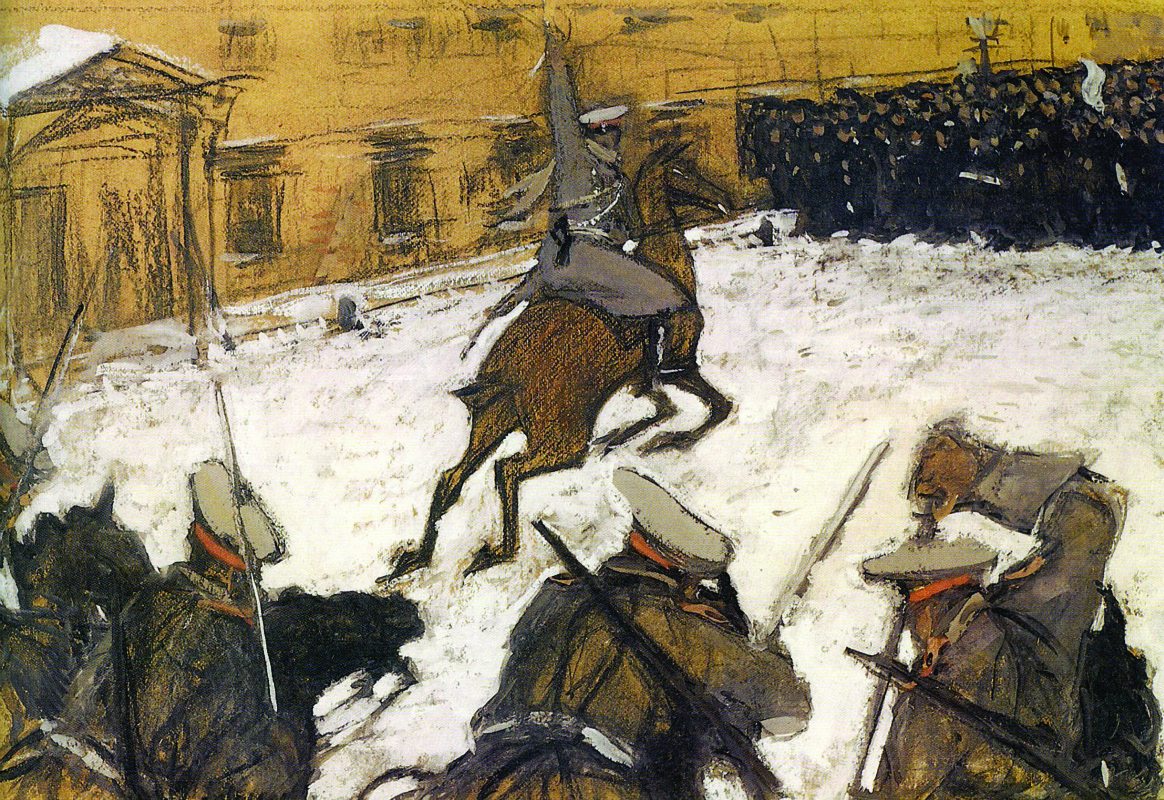log in
Enter site
Login to use Arthive functionality to the maximum
Soldiers, soldiers, where is your glory?
Valentin Aleksandrovich Serov • Painting, 1905, 47.5×41.5 cm
Description of the artwork «Soldiers, soldiers, where is your glory?»
On 9 January 1905, Valentin Serov witnessed the dispersal of a peaceful demonstration by the tsarist troops. It was a terrible sight: from the windows of the Academy of Arts, he saw horsemen’s swords sparkle in the sun, soldiers hold their guns, snow turn red with blood. What he saw changed Serov: he had no political views before, but he could no longer stay on the sidelines.
He left the Academy of Arts (the Grand Duke Vladimir Alexandrovich was its president; according to Serov, he was responsible for the massacre no less than the emperor). In the summer of the same year, Serov took an active part in organizing the Zhupel satirical magazine.
There were only three issues before the authorities shut down the magazine. In one of them, the painting Soldiers, Soldiers, Heroes Every One was published, the work as mean in form as piercing in content.
Depicting the theme, a less restrained artist could hardly have resisted the temptation to splash red on the cardboard. But Serov remained true to himself: the snow in his picture had not yet been stained with blood. The crowd is still moving in a single grey formation, but in a few seconds it will meet the cavalry barrier. The “defense” line seems to have been broken by impatience — the swords are out of their scabbards, horse nostrils are fluttering, hunting excitement is felt in the tension of the uhlans’ backs.
The animal painter Serov deliberately distorted the gallop of the horse in the vanguard: it pushed with all four legs and flies without touching the ground with its hooves. In this infernal gait, there is a powerful subtext: not the tsarist troops are moving towards the protesters, but the horsemen of the Apocalypse. Serov managed to convey the movement, the inevitable swiftness of the catastrophe. The “frame” sounds with suspense, the expectation of massacre is worse than the massacre itself.
“I will never forget what I had to see from the windows of the Academy of Arts on the 9th of January,” the artist wrote in his letter to Ilya Repin. “A restrained, majestic, unarmed crowd marching towards cavalry with rifles is a terrible sight... No one can erase this stain with anything.”
By the way, some researchers believe that Serov did not depict the events of the Bloody Sunday in this picture, but rather the dispersal of a demonstration in Moscow, near the School of Painting, Sculpture and Architecture. That’s quite possible. Unfortunately, in 1905, Serov did not experience a deficit of such events.
Written by Andrey Zymogliadov
He left the Academy of Arts (the Grand Duke Vladimir Alexandrovich was its president; according to Serov, he was responsible for the massacre no less than the emperor). In the summer of the same year, Serov took an active part in organizing the Zhupel satirical magazine.
There were only three issues before the authorities shut down the magazine. In one of them, the painting Soldiers, Soldiers, Heroes Every One was published, the work as mean in form as piercing in content.
Depicting the theme, a less restrained artist could hardly have resisted the temptation to splash red on the cardboard. But Serov remained true to himself: the snow in his picture had not yet been stained with blood. The crowd is still moving in a single grey formation, but in a few seconds it will meet the cavalry barrier. The “defense” line seems to have been broken by impatience — the swords are out of their scabbards, horse nostrils are fluttering, hunting excitement is felt in the tension of the uhlans’ backs.
The animal painter Serov deliberately distorted the gallop of the horse in the vanguard: it pushed with all four legs and flies without touching the ground with its hooves. In this infernal gait, there is a powerful subtext: not the tsarist troops are moving towards the protesters, but the horsemen of the Apocalypse. Serov managed to convey the movement, the inevitable swiftness of the catastrophe. The “frame” sounds with suspense, the expectation of massacre is worse than the massacre itself.
“I will never forget what I had to see from the windows of the Academy of Arts on the 9th of January,” the artist wrote in his letter to Ilya Repin. “A restrained, majestic, unarmed crowd marching towards cavalry with rifles is a terrible sight... No one can erase this stain with anything.”
By the way, some researchers believe that Serov did not depict the events of the Bloody Sunday in this picture, but rather the dispersal of a demonstration in Moscow, near the School of Painting, Sculpture and Architecture. That’s quite possible. Unfortunately, in 1905, Serov did not experience a deficit of such events.
Written by Andrey Zymogliadov


